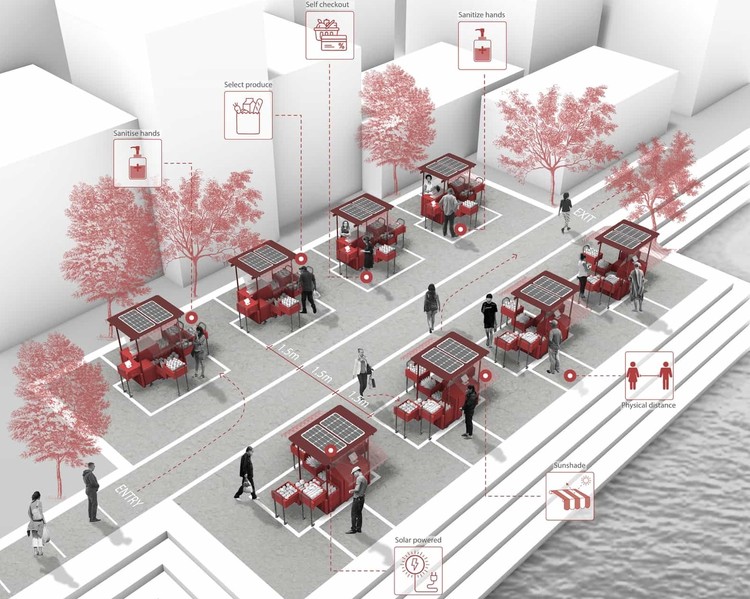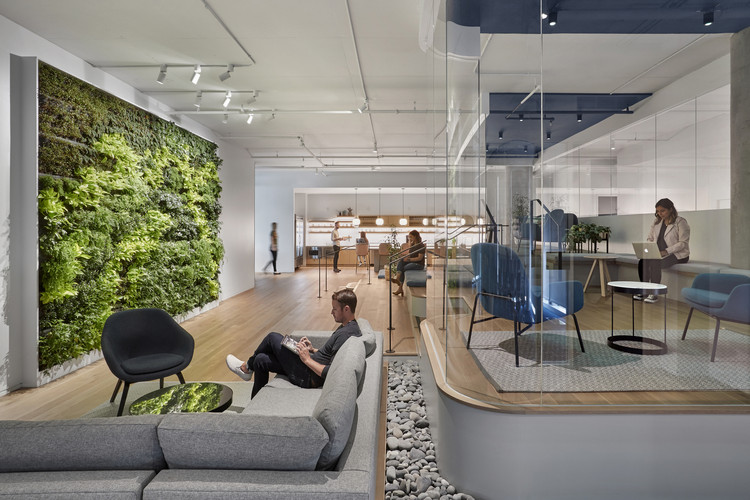The Russian Federation Pavilion announced that its exhibition Open! will "move to an entirely online presence". Coping with the recent outbreak of COVID-19 that led to the postponement of the Venice Biennale 2020, the pavilion will transform into a digital platform, to ensure the continuation of the projects.
COVID-19: The Latest Architecture and News
Open! The Russian Pavilion at the Venice Biennale 2020 Goes Completely Digital
Paola Antonelli and Alice Rawsthorn’s Instagram Live Series Examines COVID-19 Designs

The design.emergency initiative has unpacked everything from collaborative PPE production to object hacking and the power of symbolic imagery.
In the era of the pandemic, the design world’s museums, galleries, manufacturers, organizations, and independent talents have all gone virtual. An endless list of COVID-19-induced cancellations has driven most to find clever ways in which to present their work and engage their audiences. Many have opted for viewing room and interactive exhibition formats, while social media and video communication services have also played a vital role.
NACTO Releases Streets for Pandemic Response and Recovery in the Fight Against the COVID-19

The National Association of City Transportation Officials (NACTO) has released guidelines to provide cities with strategies “to redesign and adapt their streets for new uses both during the COVID-19 crisis and in the recovery”. Streets for Pandemic Response and Recovery highlights the most updated street design approaches cities are using, around the world.
MuseLAB Wins Coronavirus Design Competition

MuseLAB has won the Coronavirus Design Competition hosted by GoArchitect. The competition's challenge was to design a way to help people stay healthy, both in body and mind. The competition was made to recognize that COVID-19 has affected billions of lives, of every nationality, if not physically than economically and mentally.
7 Design Guidelines for a Safe Post COVID-19 Transition

In order to ensure a proper transition into post COVID-19, architects, public health experts, and engineers are generating design guidelines to provide people with new secure, and efficient resources. Finding a balance between optimizing operations and keeping people safe, the strategies tackle the built environment that surrounds us, from restaurants and outdoor dining, to streets, offices, and retail.
Addressed to city officials, owners, and employers, the tools developed help to reopen the world, while reducing the risk of COVID-19 transmission, promoting social distancing standards, and enhancing wellbeing. Discover in this article a roundup of design guidelines securing a safe post coronavirus transition.
AIA Releases Design Strategies for Safer Schools post COVID-19

The American Institute of Architects (AIA) has just released strategies, illustrations, and 3D design models in order to help reduce the risk of COVID-19 in schools. In an effort to assist education officials with reopening schools during the pandemic, the design guidelines are part of the AIA’s initiative “Reopening America: Strategies for Safer Buildings”.
Socially Distant Outdoor Yoga Domes Invade the Open Spaces of Toronto

A new pop-up intervention installs 50 private, clear, frameless, geodesic domes in the open spaces of Toronto, Canada. Created by Lmnts Outdoor Studio, the project aims to bring Yoga and fitness workouts safely, to an outdoor setting, while respecting social distancing measures.
RIBA Releases COVID-19 Recovery Guidance

The Royal Institute of British Architects (RIBA) has published guidance to help practices navigate recovery from the COVID-19 crisis. The Recovery Roadmap is divided into three phases: Response, Recovery and Resilience. Each phase considers a series of actions that practices can take to respond to challenges across different areas of their business throughout this crisis and beyond.
3 Major Architecture Firms Propose School Buses and Shipping Containers for Accessible Testing Labs

Despite all the news of re-openings, lifted restrictions, al fresco options dining, and a return to something more closely resembling “normal,” COVID-19 is still very much with us. And despite the defeatist/downplayed/nothing to see here stance embraced by the current presidential administration, the United States is still in the midst of an unprecedented public health crisis. In some states, both new reported cases and hospitalizations have now reached record highs.
This being said, the need for accessible, easy to fabricate, and quick-to-deploy testing facility solutions are still in great need, particularly in dense urban areas, at large institutions and workplaces, and in underserved communities where coronavirus testing might come as a luxury, not a basic necessity. In terms of testing availability, all bases need to and must be covered.
First U.S. Exhibition of Pritzker Prize-Winner Balkrishna Doshi to Open in September

Wrightwood 659, a private institution located in Chicago’s Lincoln Park neighborhood, will host the first U.S. Exhibition of Indian architect, urbanist, and 2018 Pritzker Prize winner Balkrishna Doshi. Running from September 9 till December 12, 2020, the retrospective entitled Balkrishna Doshi: Architecture for the People, is the first display devoted to the works of the laureate, outside of Asia.
After COVID-19, What’s Next for Landscape Architecture?

The urban crisis brings many challenges, but also presents opportunities for landscape architects to help build more equitable green spaces and cities.
As a Los Angeles resident who doesn’t drive, navigating the city on foot and bike has always made me feel like I have the whole place to myself.
But over the last two months, Angelenos have been freckling the streets—it’s like they’ve all discovered for the first time that they’re capable of exploring this city without a car. While most beaches and trails in the city were shuttered (they have since re-opened), I noticed the LA River becoming the city’s new “it spot” for socially distant hangouts. And in a city that lacks adequate public parks, people are turning any patch of grass or sidewalk—whether it’s an elementary school yard, a traffic median, or a bit of concrete next to a parking lot—into a bit of respite from the madness.
Curl la Tourelle Head Builds First Socially Distanced Tent for a London Primary School

Curl la Tourelle Head Architecture has built the first socially distanced tent, a pop-up school proposal in London. Located at Manorfield Primary School in Tower Hamlets, the project aims to maximize social distancing measures among students and teachers, during this post COVID-19 period.
WZMH Architects Designs Smart Screening and Testing Pod for COVID-19

The Citizen Care Pod is a new initiative for COVID-19 smart screening and testing, combining intelligent technology with a modular design. Led by the Citizen Care Pods Corporation, the multi-disciplinary team, consisting of Toronto based WZMH Architects, PCL Construction, Insight Enterprises, and Microsoft, collaborated to bring the project from concept to reality in less than a month.
Systematica Releases First Assessment on Milan Public Realm, Green Areas and Gathering Places

Systematica has just released a case study on access to green areas and the public realm in the city of Milan. Focusing on the availability of these gathering spaces for residents, the research, particularly relevant in this time of the pandemic, also highlights open and not crowded public spaces, convenient for a safe social life.
Beeline, the Architectural Intervention by SO-IL, Is on Display as MAAT Reopens
.jpg?1592209486)
MAAT, the museum of art, architecture, and technology in Lisbon, Portugal has officially reopened its doors on June 10, unveiling to the public the new projects originally scheduled to launch before the Covid-19 lockdown, such as Beeline, an architecture intervention by SO – IL. Transforming the museum into a landscape of encounters and conversations, this exhibition also generates a temporary second entrance to the gallery space.
Paul Goldberger on Architecture, Cities, and New York’s Long Road Back

This article was originally published on Common Edge.
In recent weeks, we’ve seen an explosion of internet speculation about the “future of cities.” Apparently, they are either doomed—or destined to prevail. The office is dead (obviously), the office tower (especially tall ones) clearly a building type in need of a proper funeral. All kinds of chatter have subsequently ensued (we have time on our hands) about the dire outlook for public space, the impending collapse of public transportation, the inevitable return to the suburbs, even the (gasp!) demise of the luxury cruise ship. We’ll see; we’re still wandering around in the dark here and might be for some time. With that somber thought in mind, I reached out to Paul Goldberger, Pulitzer Prize-winning architecture critic and urbanist, for what I felt certain would be a nuanced and measured take on our presently fraught moment. (A note: we spoke prior to the protests, which have erupted in American cities in response to the murder of George Floyd.) For the most part, we resisted the urge to make sweeping and almost certainly premature predictions about our urban future.
AIA Releases Retail and Office Models for Reducing COVID-19 Exposure

The American Institute of Architects (AIA) has released 3D models for retail stores and office spaces to help reopen safely during the pandemic. The Design strategies use an architectural, engineering and administrative framework based upon recent public health information. They also provide cost effective options that can be implemented immediately.
Measuring the Fallout of COVID-19 for the Design Industry

At ThinkLab, our passion lies at the intersection of specification and design, where we use research to improve communications between designers and manufacturers. Today, that research is helping companies within the interiors industry make critical business decisions as we face economic uncertainty. Here, we share some recent data and insights from our Industry Impact Survey—an ongoing research initiative that we invite you to participate in.




















.jpg?1592209476)
.jpg?1592209513)
.jpg?1592209536)
.jpg?1592209452)
